


So scroll down to see 15 items currently in stock, drawn from cultures around the world, which we feel have especially incontrovertible patinas. che, per varî scopi, viene spalmata sulla superficie di oggetti diversi per es., la miscela di materie minerali e di un fissatore usata per la patinatura della carta. Patina is a term used to describe the thin layer that forms on the surface of an object over time as a result of natural aging or exposure to elements such as air, water, and sunlight. In this way, collectors are guardians and preservers of our histories, and patina is the physical evidence of the past. Mostly importantly, good patina means that an item has a real story – and that is what collecting is all about: rarely are collectors materialistic instead they are collectors of stories, and the objects they collect merely are the material evidence for their stories. And of course genuinely old items allow us to connect with the past – to connect with those who have come before, sometimes with those many centuries ago. The ‘depth’ of the surface of something that is real and old can be deep and lustrous, whereas the surface of an item that is not old or fake tends to be lifeless and dead. Items with good patina also tend to be more beautiful. Why? Perhaps it is because of our own sense of mortality and our wish to connect with objects that have greater longevity than we do. Most people don’t regard the former as being particularly valuable but the latter is held to have more esteem and more importance. Patina is the difference between a second-hand item and an antique. For many objects it is important not to merely know that it is old, but to see it. Patina refers to the wear and depth the surface of an item develops as it ages and is handled. What is patina? It is how we describe the surface of an item which allows its age and history to be evident.


 0 kommentar(er)
0 kommentar(er)
